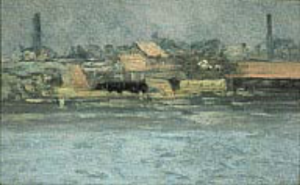Paul Fordyce Maitland (1863-1909), Battersea Waterfront (n.d)
Paul Fordyce Maitland was born with severe spinal complications, and as a result was not able to exhibit often throughout his artistic career. For this reason, his work consists primarily of impressionist landscapes and still images, often depicted from a distance. As a snapshot of what, upon closer inspection, would be a bustling city, Battersea Waterfront in particular emphasizes the mundane and everyday — important thematic elements in modernist art and literature. The crowded buildings and factory towers are portrayed in such a way that hint at the urbanism and industrialization that are essential aspects of any day in the life of a modern city.
This composition is a tone poem, or a piece that is composed to bring to life the content of a poem or literary work. Symphonia Domestica was composed by Richard Strauss for Richard Wagner’s play, The Master-Singers of Nuremberg. The composition illustrates the ordinary, family life of one of the characters, depicting the same image of the daily and the mundane in the same way that Maitland does in Battersea Waterfront. This piece corresponds with the passage featured on this page.
“But come summer, autumn, and winter,
much trouble and turmoil in life,
along with some marital happiness,
christenings, business, quarrels, and fights:
those who, then, will still be able
to sing a beautiful song,
see: they are called Masters!”
– The Master-Singers of Nuremberg (Act III) by Richard Wagner (1868)
Above is a depiction of the daily scenes one might have encountered in London in the 1920s, a close-up supplement to Maitland’s depiction of the city from a distance.
Categories: Impressionism, The Mundane, Nature, Urbanism and Industrialism, The Flaneur


